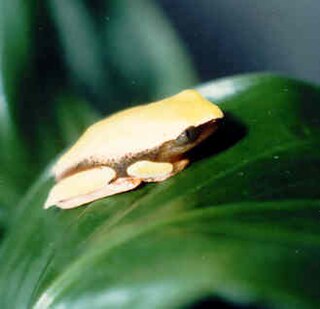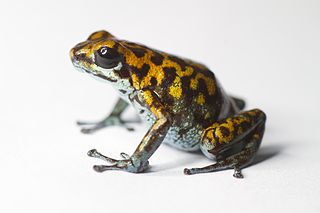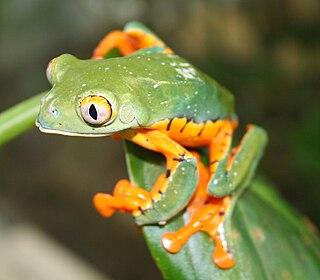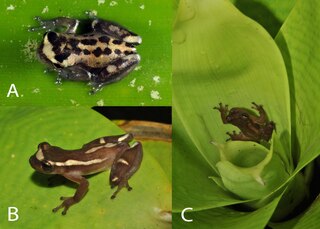
Hylidae is a wide-ranging family of frogs commonly referred to as "tree frogs and their allies". However, the hylids include a diversity of frog species, many of which do not live in trees, but are terrestrial or semiaquatic.

The saddleback toads (Brachycephalus) are a genus of tiny toads and frogs in the family Brachycephalidae in the order Anura, ranging from south Bahia to Santa Catarina in southeastern Brazil. The genus includes two main groups, the often brightly coloured pumpkin toadlets, and the overall brown and more frog-like flea frogs, which once were placed in their own genus Psyllophryne. Some pumpkin toadlets are toxic and their often bright colours are considered aposematic. At about 1 cm (0.4 in) or less in snout–to–vent length, the flea frogs are some of the smallest frogs in the world.

Phrynomedusa is a genus of tree frogs from the Southeast and South regions in Brazil. They were formerly considered to be part of the genus Phyllomedusa, as the "Phyllomedusa fimbriata group". Common names colored leaf frogs and monkey frogs have been coined for them.
The sky-blue poison frog is a species of poison dart frog. It is endemic to Peru and known from the lower eastern versant of the Andes in the upper Amazon basin of the San Martín Region.

Vicente's poison frog is a species of frog in the family Dendrobatidae that is endemic to the Veraguas and Coclé Provinces of central Panama.
Phrynomedusa fimbriata, the spiny-knee leaf frog, is an extinct species of tree frog. It was endemic to Brazil, where the only known specimen was discovered near Paranapiacaba in the state of São Paulo. The type locality was given as Alto da Serra. While the species might still exist, having only been found once in the 1898, no trace of any individuals have been discovered in successive expeditions.

Phrynomedusa marginata, the bicolored leaf frog, is a species of frog in the subfamily Phyllomedusinae. It is endemic to Brazil. People have seen it between 600 and 800 meters above sea level.
Phrynomedusa vanzolinii, or Vanzolini's leaf frog, is a frog in the subfamily Phyllomedusinae. It is endemic to southeastern Brazil where it is currently known from Teresópolis in the state of Rio de Janeiro and Boraceia in the state of São Paulo, Brazil. It is possible that this species is a synonym of Phrynomedusa appendiculata.
Pithecopus ayeaye, also known as the reticulated leaf frog and reticulate leaf frog, is a species of frog in the subfamily Phyllomedusinae. It is endemic to Brazil. P. ayeaye is found in the transition zone between cerrado and Atlantic semi-deciduous forest, laying its eggs on leaves above streams or pools so the tadpoles, when hatched, fall into the water below. This species is under threat from habitat loss resulting from mining activity and fires, and is also affected by pollution from mining and pesticides. Its restricted range is likely to make it particularly vulnerable to these threats.

Phyllomedusa camba or the black-eyed monkey frog is a species of frog in the subfamily Phyllomedusinae. It is found in Bolivia, Brazil, and Peru. It has been observed between 280 and 1000 meters above sea level.

Scinax alter, the Crubixa snouted treefrog, is a species of frog in the family Hylidae endemic to Brazil.

Hylodes sazimai is a species of frog in the family Hylodidae. It is endemic to Brazil. Its natural habitats are subtropical or tropical moist lowland forest, subtropical or tropical moist montane forest, and rivers. It is threatened by habitat loss.

The pumpkin toadlet, or Spix's saddleback toad, is a small and brightly coloured species of frog in the family Brachycephalidae. This diurnal species is endemic to southeastern Brazil where it is found among leaf litter on the floor of Atlantic rainforests at an altitude of 200–1,250 m (660–4,100 ft). It is found in Espírito Santo, Rio de Janeiro, southeastern São Paulo and southeastern Minas Gerais. Although its type specimen supposedly was collected in Bahia about 200 years ago, there are no confirmed localities in this state and recent reviews consider it more likely that it was from Rio de Janeiro. B. ephippium is locally common, quite widespread compared to most other species of Brachycephalus and it is not considered threatened.

Cruziohyla calcarifer, the splendid leaf frog or splendid treefrog, is a species of tree frog of the subfamily Phyllomedusinae described in 1902 by George Albert Boulenger. It has a distribution from Esmeraldas Province in northwestern Ecuador, through western Colombia and Panama to the most southerly part of Costa Rica. It is a nocturnal, arboreal frog inhabiting primary humid lowland forest. The tadpole of this species was described in 2021

Ecnomiohyla rabborum, commonly known as Rabbs' fringe-limbed treefrog, is a possibly extinct species of frog in the family Hylidae. They were relatively large frogs that inhabited the forest canopies of central Panama. Like other members of the genus Ecnomiohyla, they were capable of gliding by spreading their enormous and fully webbed hands and feet during descent. The males of the species were highly territorial and would guard water-filled tree holes used for breeding. They were also the ones responsible for guarding and caring for the young, including providing food. They were the only known species of frog where the tadpoles derived nutrition by feeding on the skin cells of their fathers.

Scinax tropicalia, or Tropicalia's snouted treefrog, is a frog. Scientists report two distinct populations, both in Atlantic forest in Brazil. It lives no more than 600 meters above sea level.
Scinax cabralensis is a frog in the family Hylidae. It is endemic to Brazil. Scientists observed some of these frogs 1070 meters above sea level.
Boana cambui is a frog in the family Hylidae. It is endemic to Brazil. Scientists have seen it 905 meters above sea level.

Dendropsophus bromeliaceus, or Teresensis' bromeliad frog, is a frog in the family Hylidae, endemic to Brazil. Scientists have only seen it in the mountains in the Reserva Biológica Augusto Ruschi.\
Hylodes cardosoi is a species of frog in the family Hylodidae. It is endemic to the state of São Paulo in Brazil.










